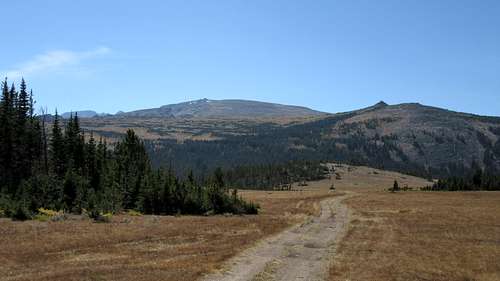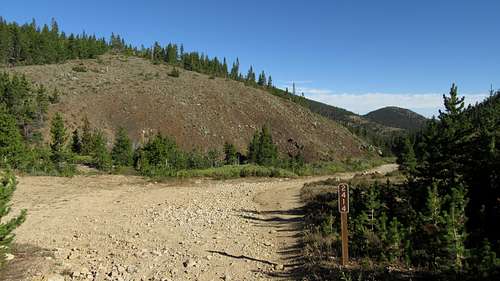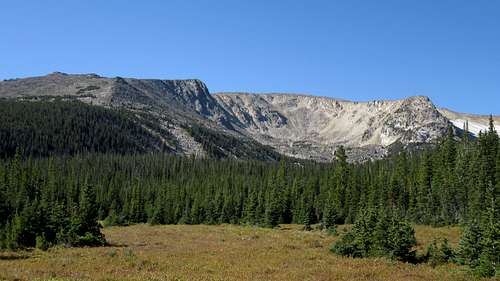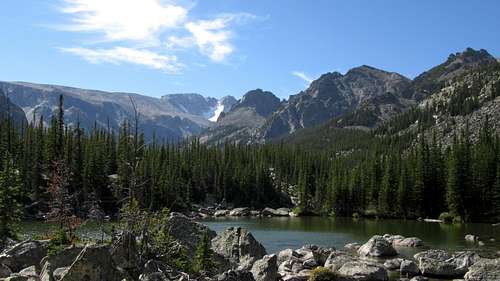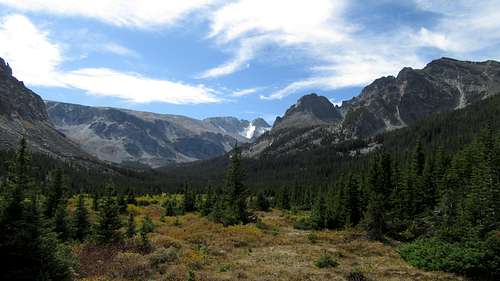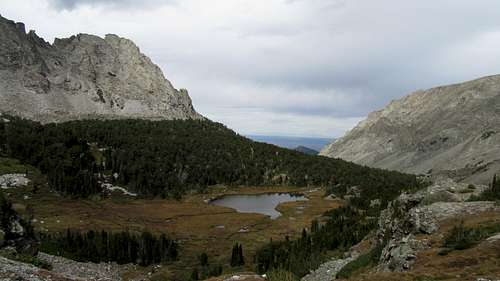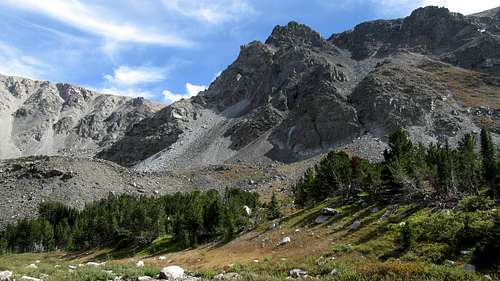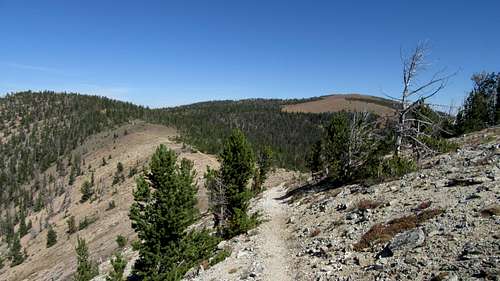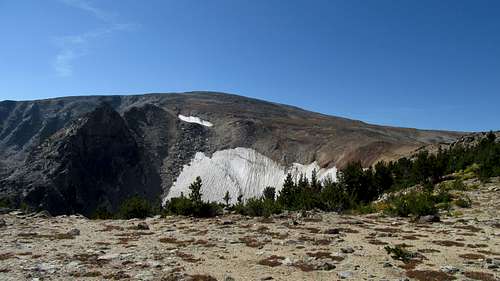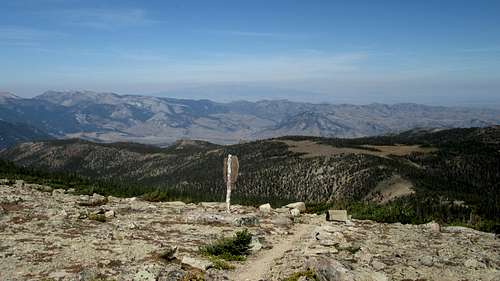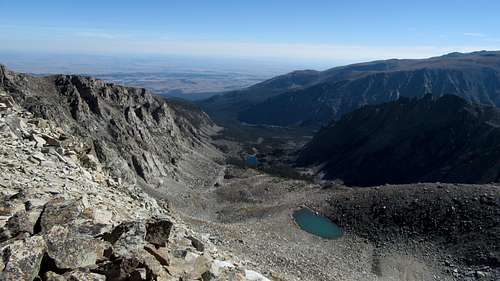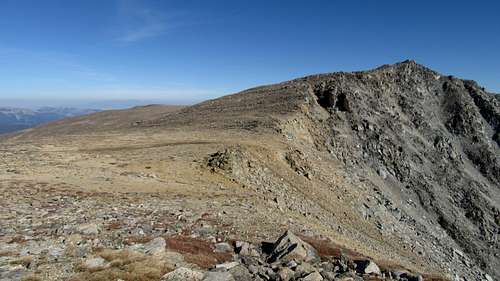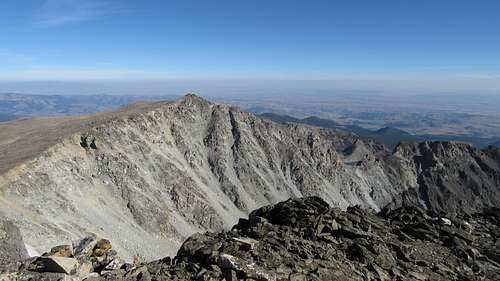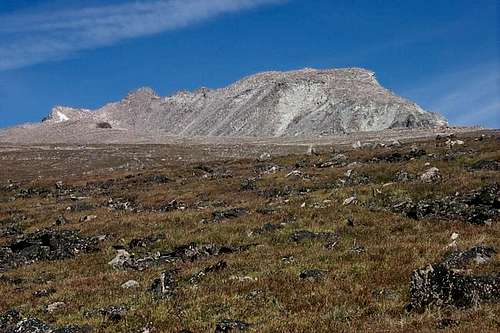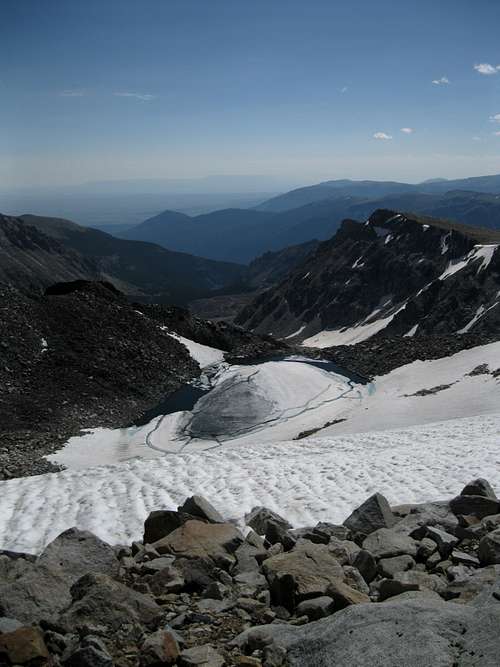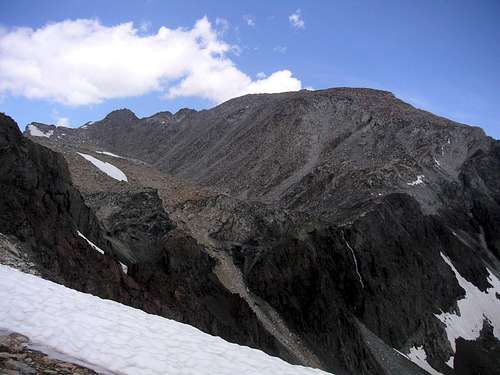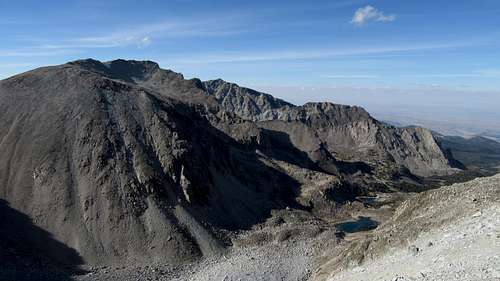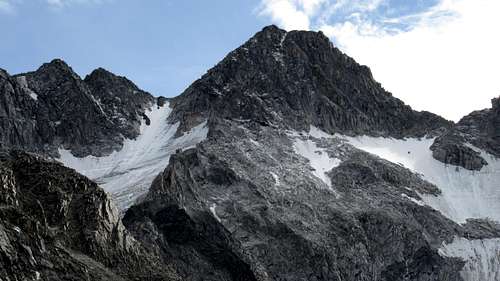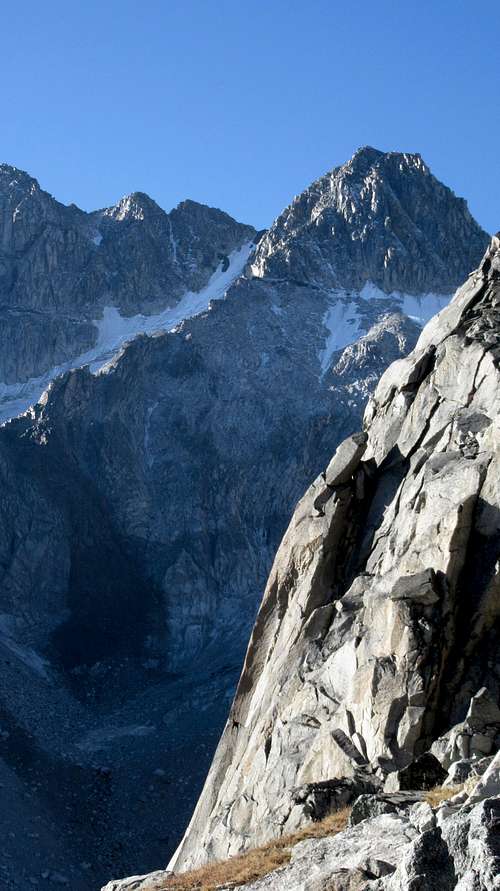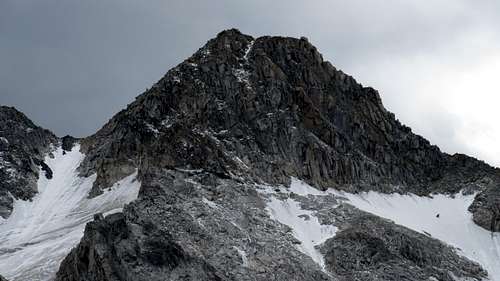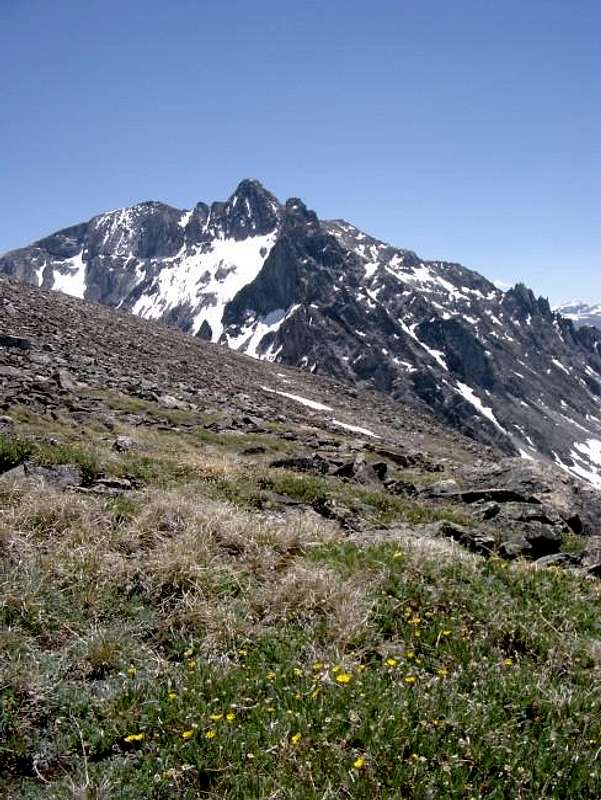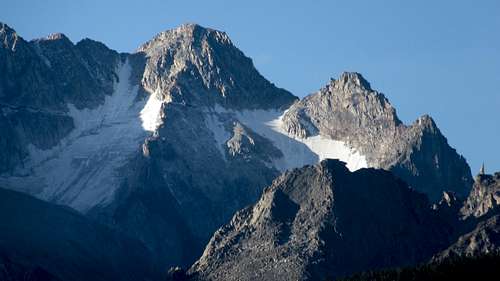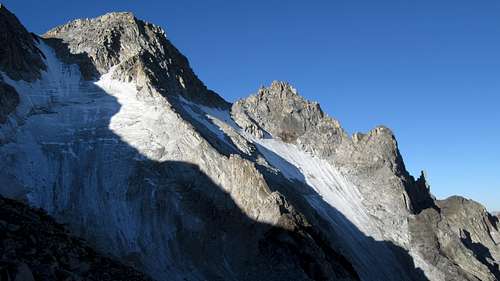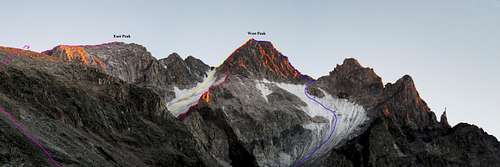-
 58986 Hits
58986 Hits
-
 89.28% Score
89.28% Score
-
 29 Votes
29 Votes
|
|
Mountain/Rock |
|---|---|
|
|
45.27515°N / 109.8127°W |
|
|
12649 ft / 3855 m |
|
|
Overview
Topping out at 12,649 feet (just 150 feet shy of Granite Peak), Mount Wood stands out as the third highest ranked peak in Montana, and the highest point in Stillwater county. Mount Wood sees very few visitors due to its relative inaccessibility and a lack of official trails to its lonely summit. The easiest route entails a moderately long hike up a good trail along West Rosebud Creek, followed by a strenuous hike up steep slopes along the south side of the mountain, some of which involves annoying bushwhacking. The peak can be climbed in one very long day, but people will no doubt normally take a couple days with a camp along the west end of Mystic Lake.
The view from the summit of this peak is astounding. The steep north face drops away draped in permanent snowfields, while Granite Peak is clearly visible directly to the south. In the distance one can see a magnificant line of peaks including Silver Run, Whitetail, the Castles (Castle Peak, Castle Rock, Castle Rock Spire), and Snowbank Mountains. Many routes have been done on this peak including lines on the north side which makes this mountain a good objective for all levels of hikers/climbers. Note however that approaching this mountain from the north is much more involved with more bushwhacking and even more remote terrain.
One interesting note about Mount Wood is that it has two distinct summits. The east and west summit are separated by just a quarter mile of ridgeline however no one has really determined for sure which one is higher. The USGS map for the area labels the east peak as the summit, however a number of climbers who have reached the summit of both peaks (traversing between the two is a fairly straightforward Class 3 scramble), have said that the west peak appears slightly higher when tested with GPS and compass sighting equipment. For the sake of this page, I won't definitively say one is higher than the other, and I'll include route beta for both summits.
West Rosebud - The West Rosebud Trailhead is located approximately 80 miles southwest of Billings. To reach the trailhead, take the Columbus exit from Interstate 90, and take Montana Highway 78 through Absaroka and turn west (right) toward Fishtail (approximately 17 miles from Columbus). From Fishtail, drive west and south for 1 mile and turn south (left) on West Rosebud Road. Follow this paved road for 6.3 miles until reaching a fork in the road and a large brown Forest Service sign. The sign will indicate West Rosebud Lake Road #2072. Turn left here and follow the dirt road for 14.4 miles until reaching the trailhead. The trailhead has toilet facilities, and a large parking area. Please obey the posted private property signs and do not drive beyond the trailhead parking area.
Benbow Mine (Golf Course) - The Benbow Mine (aka Golf Course) trailhead is the normal starting point for people wishing to access the north side of Pyramid Mountain. This trailhead is unmarked and difficult to get to. A tough passenger car can make to the Benbow Mine but a high clearance 4WD vehicle is advised, and certainly required if you plan to drive beyond Benbow Mine. Note that in the "Hiking the Absaroka-Beartooth Wilderness" Falcon Guide book, this trailhead is called the Lake Wilderness trailhead. Information about getting here can be found on page 97 of this book.
In short, if coming from Red Lodge, start from the MT 308 and US 212 junction at the south end of town and drive north on US 212 for 1.5 miles and turn left onto MT 78. Continue on this road west for 30 miles and turn left on CO Road 419 (also called Nye Road) and continue on this road for 14 miles passing through the small town of Fishtail on the way. Just past the Montana Jacks Bar and Grill in the tiny town of Dean, turn left (south) onto Benbow Road (FS 1414). Drive this very windy road as it switchbacks up to the Benbow Mine head frame after 11.4 miles at an elevation of 8,480 feet. Park passenger cars here. 4WD vehicles can continue driving up a series of switchbacks, which were likely used when the mine was active, for an additional 2 miles to a large open meadow land known as the Golf Course (apparently some miner thought it looked like a golf course). The road continues down a short ways to the trailhead at the south end of the meadow at an elevation of 9,100 feet. A sign marks the end of the road.
Approaches
West Rosebud Creek Approach
The West Rosebud Trail actually begins up the road from the trailhead about 200 yards, and is reached by walking through the Montana Power Company facilities where the trailhead is clearly marked with a Forest Service sign. From there, the trail leads up toward 7,637 foot Mystic Lake, one of the most popular day hikes in the Custer National Forest. The trail is relatively flat for about the first two miles, leading to switchbacks that eventually bring the hiker to a point looking over Mystic Lake Dam. The total elevation gain is about 1,200 feet over 3 miles. Once at the dam overlook, descend down to Mystic Lake and continue hiking for a half mile until reaching an intersection for the Phantom Creek Trail #17 branching to the left (south). Continue straight at the junction and continue an additional 2 miles along the south shore of Mystic Lake to its west end where the trail crosses a series of logjams right at the outlet to Island Lake. Crossing these logs can be difficult in early season. Once across the logs, there is a huge flat area offering great camping in sparse forest. If you are doing the climb as an overnight, camp here as the route up starts heading steeply up shortly beyond.
West Fishtail Lakes Approach
This route begins near the Golf Course Trailhead (see above), and utilizes the approach to West Fishtail Lakes. This approach isn't particularly fun, but is guarantees solitude and offers a sense of adventure above and beyond many other areas of the Beartooths. I wasn't able to get much beta for this approach from Red Lodge locals since hardly anyone ever goes up there. This is one route where 90% of the effort really is done in the approach. Rather than starting at the Benbow Mine (end of rough 2wd road), take the spur road which heads left at the second to last switchback before reaching the mine. This road passes by some old mine tailings below, and gently gains elevation for a half mile until it reaches a large open area with many junctions and a small creek crossing. Do not take the left road, which will head over the small hill, pass to the north of Chrome Lake and begin descending steeply down the valley to the east. Instead, continue straight and follow the road that traverses south of Chrome Lake. It's best to park cars here, but 4wd vehicles can continue the final .7 mile to where the road makes a sharp U-turn to the left. Park here where the elevation is 8,500 feet (the road ends just a few feet further) and begin bushwhacking through dense trees heading due south. You'll gain about 150 feet over a painful quarter mile at which point you will reach a large area of blow down. Crossing this area of downed trees is one of the cruxes of the approach. It's a large maze of pick-up sticks that are ready to stab you if you aren't careful! Once past this obstacle though, you will reach an open meadow at 8,750 feet where the valley above flattens out.
Hike SW to the opposite end of this meadow, then continue bushwhacking due south again, over a small rib and across the stream draining the small lake above. Once across this stream, it's an additional steep 300 feet up to the large ridge separating the valley you're in with the West Fishtail Creek Valley. This is the same ridge you can see from the road near where you parked. Once on top of it at around 9,050 feet, descend due south (this will be a descending traverse rightward...do not descend directly down the slope) to a small pond at 8,550 feet. This slope down has less trees and more talus making travel slightly easier. You are now 50 feet above your car, but the worst of the approach is over. From this pond, hike up the gentle valley staying to the right of the main creek. There will be some marshy areas without trees so if you don't mind some wet feet, you can avoid the bush this way.
You will reach a huge open meadow a though which makes a big part of the valley go much quicker. Here, you should find a small trail that can be followed for 1.5 miles all the way to about 9,100 feet where the valley begins to steepen. From this point the trees are thin enough that you can easily continue SW up the hill to the first lake at 9,600 feet. Great camping can be found here, or you can continue south to the largest lake 100 feet higher which also has excellent camping. The highest lake at 10,000 feet doesn't have any good camp spots for a tent, as it's mostly surrounded by large talus, but you could probably find the bivy spot I made under a large boulder just before the lake.
Stillwater Plateau Approach
This is an alternate approach to the north side of Mount Wood and although does not have any bushwhacking like the West Fishtail Lakes approach does, it is high and exposed to the afternoo storms and should only be done when the weather is perfect. It also has copious amounts of large boulder-hopping and despite the higher starting elevation (assuming you can drive to the end of the 4WD road), the elevation gain is about the same since you will have to descend abut 1,400 feet on the approach in and camp in the same area as per the West Fishtail Lakes Approach.
From the trailhead at the end of the 4WD road at the golf course, begin hiking south on the nice trail as it descends for a few minutes and crosses a broad saddle between the head of two creeks; Little Rocky Creek to the east and Flume Creek to the west. Past this, the trail weaves through an open forest and reaches meadows around 9,500 feet. The trail then makes a series of long switchbacks up the meadow, and reaches a SW-NE ridge at 9,900 feet where views to the south open up showing an unnamed lake in a small basin below. The trail continues in a SW direction along the top of the ridge to a flat area at the top of a large permanent snowfield at 10,060 feet. Two large cairns mark the end of the constructed trail a few minutes beyond this spot. It's 2 miles from the end of the 4WD road to the end of the trail, and the trail is in great condition when not snow covered.
From the end of the trail, continue south for an additional 2.7 miles along the plateau to the 11,340 foot saddle just north of the Stillwater Plateau HP (Point 11,817).The best way to cross the plateau is to hike over Point 10,819, and contour west around Point 11,649 at around the 11,300 foot contour. The talus on the plateau can be quite large in spots so plan for a tedious hike. Once at the 11,340 foot saddle, continue hiking SE another 0.3 miles to the summit of Stillwater Plateau HP. The total one way distance from the end of the 4WD road to this summit is 5 miles, and will take even the most seasoned hikers at least a few hours to reach due to all the boulder hopping. Views of Mount Wood just across the West Fishtail Valley to the north are intimidating.
From this point, descend south to the broad 11,120 foot saddle between Stillwater Plateau HP and the west peak of Mount Wood, then as you reach the base of a small rock tower, descend east down horribly loose scree to the highest lake in the basin (see West Fishtail Lakes approach above). Camp at either the second highest lake or the bivy spot at the upper-most lake.
Route Options
East Summit Routes
Southeast Slopes via West Rosebud Standard Route - Class 2+
This route is the easiest way up the mountain and takes you to the east peak. From the flat forested area at the west end of Mystic Lake (good camping), ascend due north up the valley picking your way through the trees. Stay on the right (east) side of the creek until about 9,600 feet, at which point you will turn northeast and make an ascending traverse up tundra and talus towards two small tarns just south of the summit. There is a moderately steep snowfield that lingers well into summer just below and surrounding these two tarns. From the upper 11,800 foot tarn, pick the easiest way up the steep south facing slopes to the summit. This route gains nearly 4,800 feet and can take much of a day for non-acclimated parties.
NE Ridge - Class 2+
This route is approached from the north side of the mountain. From the upper most West Fishtail Lake at 10,200 feet, begin ascending up grass and talus southeast aiming for a small gully that passes through a cliff band. Water can be flowing here. Once above the cliff band at around 10,900 feet, the slopes open up into huge talus fields. Make a rightward ascending traverse to the south until you reach a small flat area just above the basin formed by the dying glacier dropping off the north side of Mount Wood. Do not descend into this basin but continue left up the talus towards the broad ridge above. Crest the ridge at roughly 12,100 feet and turn right. Follow the mellow ridge over large boulders to the east summit.
North Face Snow/Ice Route - Class 3 & Steep Snow
This route is a bit more difficult than the two above because it involves snow/ice up to 50 degrees. Start from the same 10,200 foot lake in West Fishtail Basin and ascend per the NE Ridge route above. When you reach the small flat area just above the glacial basin, drop southwest 60 feet into the talus filled basin at 11,300 feet rather than ascending towards the NE Ridge. In early season this will be all snow covered but by mid-August, this basin will be filled with huge boulders and some remnant ice from the glacier. In really late season, the entire route from this basin may be bullet ice and require ice screws/tools to ascend. Begin ascending the obvious snow/ice that heads directly to the low notch between the east and west peaks. The final 300 feet exceeds 45 degrees just barely. From the notch, it's a Class 3 scramble east up the ridge to the east peak.
West Summit Routes
North Rib - Class 5.6
This route is also approached from the north and begins from the 11,300 foot glacial basin at the base of the north face. Rather than ascending the snow per the route just above, traverse across this basin to the far west end and ascend loose black covered rock which marks the base of the North Rib. Scramble up loose Class 3 staying on or near the crest of the rib until a small notch with an 8 foot drop. Just beyond this notch is a 50 foot pitch up 5.6 rock utilizing good cracks. Above this rock step, the rib levels out and runs over a series of small towers than can be bypassed (Class 3-4) until you reach the steep headwall. Here a few pitches of climbing up to 5.6 on questionable rock leads to easier terrain, and the final 200 feet to the summit is a scramble once again. Bring one set of cams to 2", a set of nuts and a single 50 or 60 meter rope. Traverse to the East Peak and descend the NE Ridge route described above.
NW Ridge - Class 5.6
This more adventurous route ascends the snowfield on the west side of the north rib to a notch in the NW ridge between the west peak of Wood and Point 12,260 just to the NW. For the prudent peakbaggers, this peaklet exceeds 12,000 feet, but has less than 300 feet of prominence. Climb it if you like, but be prepared for more 5.6 climbing and have cord to make your own rappel anchors. From the notch, climb the NW ridge towards the west peak of Mount Wood up Class 3-4 terrain initially, and reach the first rock step about halfway up the ridge from the notch. I haven't done this route so I cannot say how difficult this rock step is but I would guess it would be in the 5.6 range. Continue up more Class 4 to the second rock step just below the summit. This can be bypassed to climbers right up a very steep gully (Low 5th). Above this gully its a 50 foot scramble to the summit (Class 3).
East to West Summit Traverse - Class 3
Might as well do them both if you are up there. The traverse is at times airy but mostly solid rock and does not exceed third class.
Camping/Red Tape
As with the other Beartooth Peaks, there are no permits or fees, and the West Rosebud road is open all year. If you try the Benbow Mine/West Fishtail approach, deep snow will probably block the road from late fall through mid-June. There are two campgrounds in the West Rosebud drainage, and one of them, called the Emerald Lake Campground, is right at the base of the climb just a minute or so from the trailhead. There are fees to camp here, however you can pull off at any reasonable pull-out along the road once you enter the National Forest and camp free of charge. You can also camp on the mountain, with a spot somewhere in the upper West Fishtail Lakes basin on the north side being the best. Camping on the south side of the mountain is best done on the west end of Mystic Lake just after crossing the logjam. Higher up, few, if any flat areas with access to water are found.When To Climb
The easiest time of the year to climb Mount Wood is from about mid-July to mid-September. With considerable snow on the ground, this could turn into quite an arduous journey, especially once you gain treeline where the wind and spin drift will certainly carry you away. However, if you climb in good weather, snow cover should make the ascent much easier and more fun. Just be sure to have an ice axe and good boots, along with very adequate warm clothing. The standard route can be done reasonably in winter providing avalanche conditions are safe.North Side Topo
Here is a photo showing the various routes on the north side of Mount Wood.
External Links
See Ron's "Alpine Select" Guidebook for more information on technical climbing routes on Mount Wood, as well as all of Montana!




